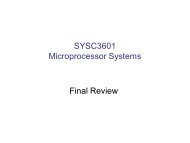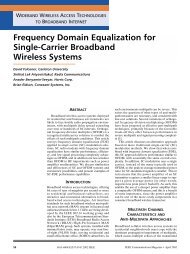Image Reconstruction for 3D Lung Imaging - Department of Systems ...
Image Reconstruction for 3D Lung Imaging - Department of Systems ...
Image Reconstruction for 3D Lung Imaging - Department of Systems ...
You also want an ePaper? Increase the reach of your titles
YUMPU automatically turns print PDFs into web optimized ePapers that Google loves.
(a) L 2 solution with 2.5%<br />
AWGN, first step. Noisy<br />
but useful reconstruction.<br />
(b) TV solution with 1.5%<br />
AWGN, first step. Noise<br />
dominated solution.<br />
Figure 7.9: <strong>Reconstruction</strong>s <strong>of</strong> Phantom A.<br />
Iteration 8<br />
L1<br />
L2<br />
phantom<br />
Figure 7.10: Phantom B pr<strong>of</strong>iles.<br />
In our work numerical experiments this did not result always in a significant improvement in<br />
reconstructed images. We adopted there<strong>for</strong>e a the arrangement <strong>of</strong> not updating the Jacobian<br />
at each single iteration. This provides a reduction in the reconstruction computational time.<br />
As an additional numerical experiment, we evaluated the use <strong>of</strong> the same regularization<br />
matrix L as <strong>for</strong> TV regularization, (equation 7.9), with the quadratic algorithm (7.3).<br />
Although reconstructions from the first step were identical to TV reconstructions, the<br />
quadratic solutions rapidly degraded, producing noisy reconstructions that were dominated<br />
by noise artefacts after the 10 th iteration. The TV prior is not recommended <strong>for</strong> use with<br />
the quadratic algorithm.<br />
7.4.6 Preliminary testing in <strong>3D</strong><br />
The generality <strong>of</strong> the PD-IPM scheme allows its use <strong>for</strong> the <strong>3D</strong> EIT reconstructions. The<br />
method was expected to work equally well in three dimensions, and to be easily extended<br />
to this case. To validate this a single experiment with the simulated tank <strong>of</strong> figure 7.15 was<br />
per<strong>for</strong>med. The tank has 315 nodes, 1104 elements, 32 electrodes and is constructed <strong>of</strong> 4<br />
identical layers <strong>of</strong> tetrahedrons and was used <strong>for</strong> both simulating data and reconstruction. A<br />
single object in the shape <strong>of</strong> a crescent was used to generate simulated data. <strong>Reconstruction</strong>s<br />
were made on the same mesh. The convergence <strong>of</strong> the PD-IPM algorithm is shown in figure<br />
7.16. Convergence occurred rapidly with a reasonable image appearing in the first iteration<br />
and convergence being achieved by the 8 th iteration - there was no appreciable improvement<br />
in the image or change in the error norm after the 8 th iteration. Figure 7.17 shows slices<br />
taken at the five layer boundaries (including top and bottom tank surfaces) <strong>of</strong> the simulated<br />
tank. Figure 7.17 shows reconstructed conductivities after the first iteration, Figure 7.18<br />
shows reconstructed conductivities after 8 iterations. The results were not as good as<br />
110





